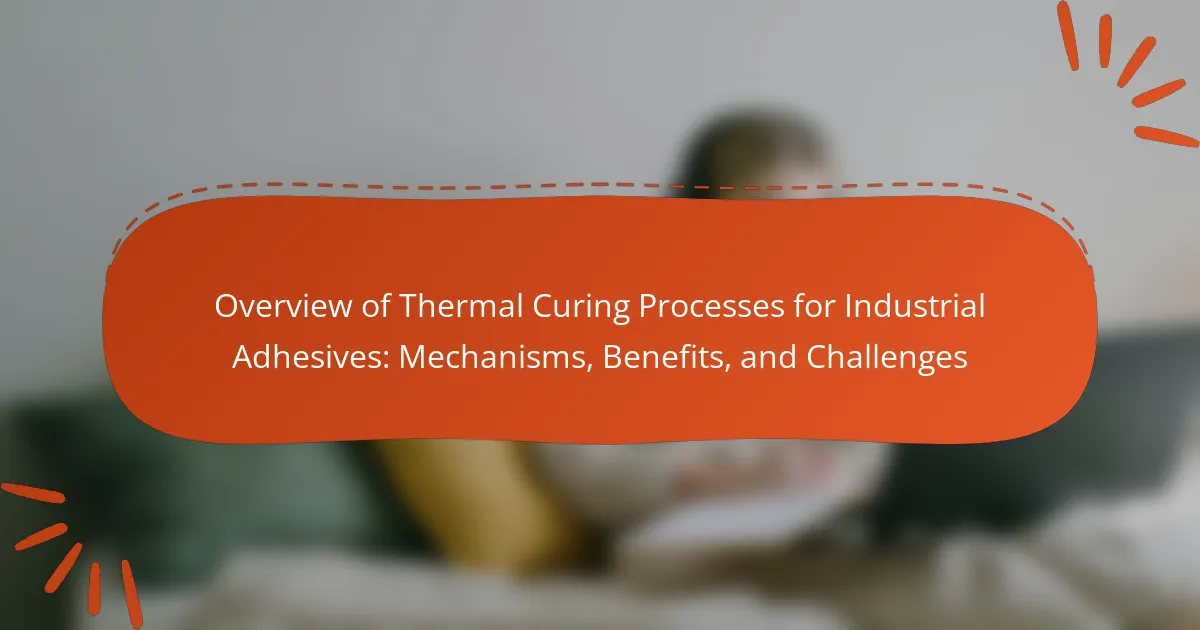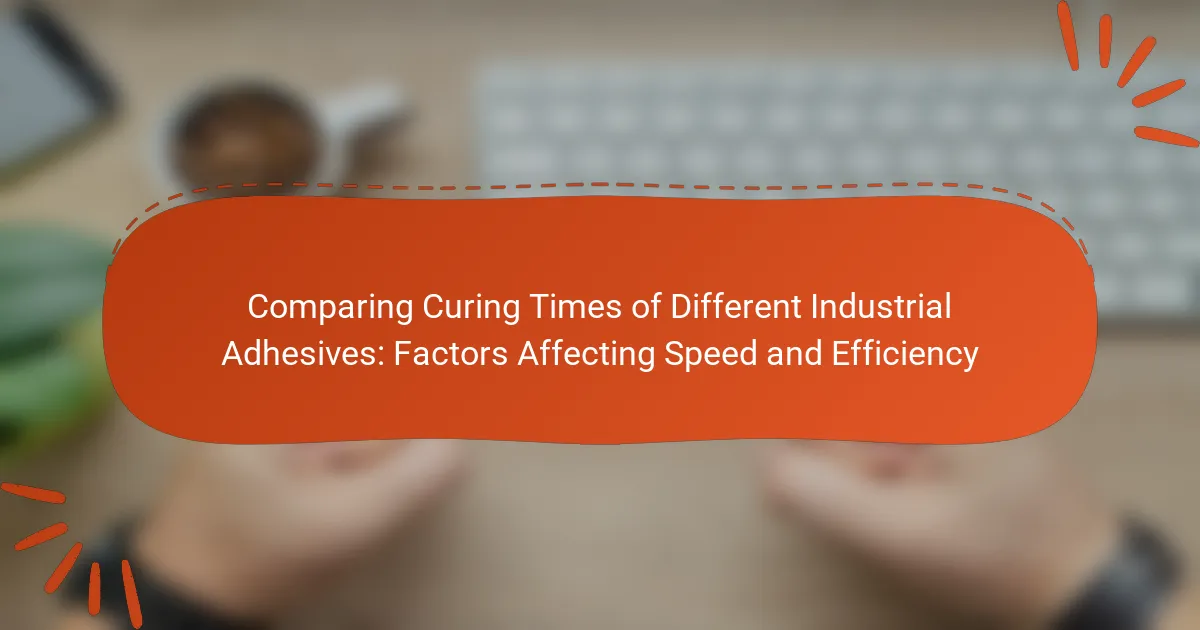Thermal curing processes for industrial adhesives involve the application of heat to initiate chemical reactions that solidify various adhesive types, including epoxy, polyurethane, and silicone. This process enhances adhesive strength and durability through cross-linking of polymer chains at elevated temperatures. While thermal curing offers benefits such as improved bond strength and faster production cycles, it also presents challenges, including the need for precise temperature control, potential thermal degradation of substrates, and safety concerns. Future trends in this area focus on developing low-temperature curing systems, bio-based adhesives, and advancements in automation to enhance efficiency and sustainability in adhesive applications.
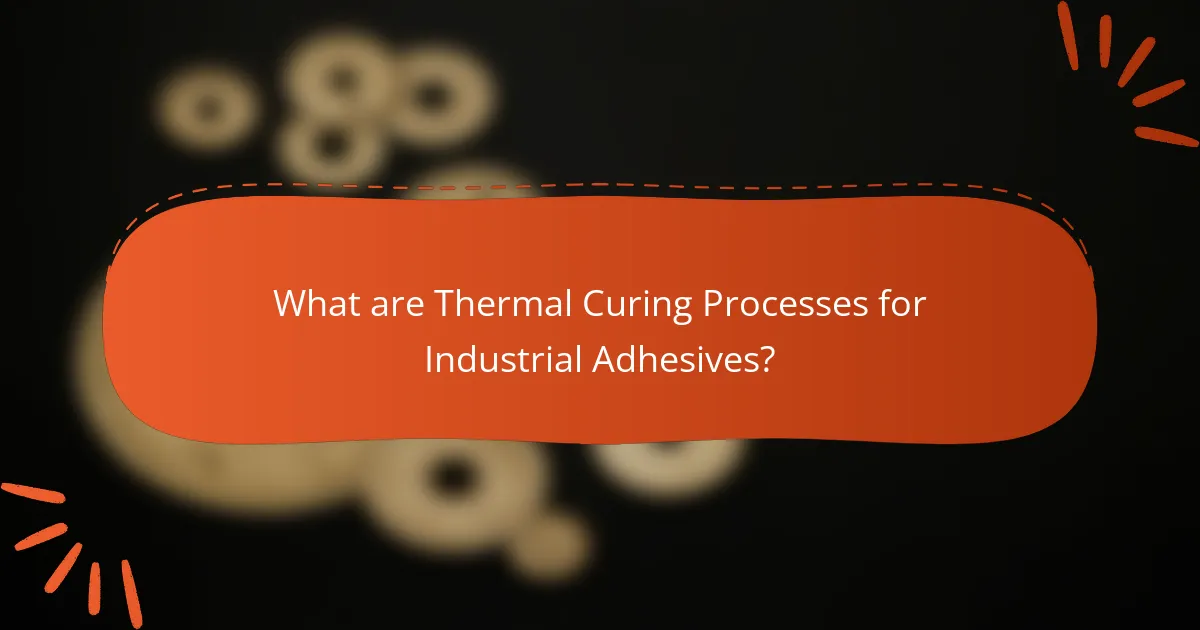
What are Thermal Curing Processes for Industrial Adhesives?
Thermal curing processes for industrial adhesives involve the application of heat to initiate chemical reactions that solidify the adhesive. This process typically occurs at elevated temperatures, which accelerate the curing reaction. Common adhesive types that utilize thermal curing include epoxy, polyurethane, and silicone adhesives.
During thermal curing, heat promotes cross-linking between polymer chains, enhancing the adhesive’s strength and durability. The curing time and temperature can vary based on the adhesive formulation and desired properties. For instance, epoxy adhesives may require curing temperatures ranging from 120°C to 180°C.
Thermal curing offers several benefits, including improved bond strength and resistance to environmental factors. It also allows for faster production cycles in industrial applications. However, challenges include the need for precise temperature control and potential thermal degradation of sensitive substrates.
How do Thermal Curing Processes function in adhesive applications?
Thermal curing processes in adhesive applications involve the use of heat to initiate chemical reactions that solidify the adhesive. This process typically starts when the adhesive is exposed to elevated temperatures. The heat activates curing agents or hardeners present in the adhesive formulation. As the temperature increases, the adhesive undergoes a series of chemical changes. These changes lead to cross-linking of polymer chains, resulting in a hardened and durable bond.
Thermal curing can enhance the adhesive’s mechanical properties, such as strength and resistance to environmental factors. Common temperature ranges for thermal curing are between 100°C to 200°C, depending on the adhesive type. The duration of the curing process can vary, often lasting from minutes to several hours. Successful thermal curing is crucial for achieving optimal performance in industrial applications.
What are the key stages involved in thermal curing?
The key stages involved in thermal curing are heating, holding, and cooling. During the heating stage, the adhesive is exposed to elevated temperatures to initiate the curing process. This stage activates the chemical reactions necessary for curing. The holding stage maintains the temperature for a specified duration. This allows the adhesive to fully cure and achieve its desired properties. Finally, the cooling stage reduces the temperature to stabilize the cured adhesive. Each stage is critical for ensuring optimal performance of the adhesive in industrial applications.
How does temperature influence the curing process?
Temperature significantly influences the curing process of industrial adhesives. Higher temperatures typically accelerate the chemical reactions involved in curing. This leads to faster polymerization and cross-linking of adhesive components. Conversely, lower temperatures can slow down these reactions, resulting in extended curing times.
For example, many epoxy adhesives cure optimally at temperatures between 60°C and 80°C. At these temperatures, the viscosity decreases, allowing better flow and bonding. Studies have shown that curing at temperatures below the recommended range can lead to incomplete curing, reducing the adhesive’s strength and performance.
In summary, temperature plays a crucial role in determining the efficiency and effectiveness of the curing process in industrial adhesives.
What are the primary mechanisms behind thermal curing?
The primary mechanisms behind thermal curing involve chemical reactions that occur when heat is applied. These reactions include cross-linking, polymerization, and degradation. Cross-linking forms covalent bonds between polymer chains, enhancing material strength and stability. Polymerization involves the transformation of monomers into a polymer structure, increasing viscosity and forming a solid matrix. Degradation can occur at elevated temperatures, impacting the integrity of the material. Together, these mechanisms define the thermal curing process, leading to the final properties of the adhesive.
What chemical reactions occur during thermal curing?
During thermal curing, several chemical reactions occur, primarily cross-linking and polymerization. Cross-linking involves the formation of covalent bonds between polymer chains, which enhances the material’s strength and durability. Polymerization is the process where monomers react to form long-chain polymers.
These reactions are often initiated by heat, which provides the necessary energy for the reactants to overcome activation barriers. For example, epoxy resins undergo a reaction with hardeners, resulting in a thermosetting polymer.
The specific temperatures required for these reactions typically range from 100°C to 200°C, depending on the materials used. The resulting cured adhesive exhibits improved mechanical properties and resistance to environmental factors.
How do curing agents interact with adhesives during the process?
Curing agents chemically react with adhesives to initiate the curing process. This interaction typically involves cross-linking, which enhances the adhesive’s strength and durability. Curing agents can be hardeners or catalysts, depending on the adhesive system. They facilitate the transformation of the adhesive from a liquid to a solid state. This transformation is crucial for achieving optimal bonding performance. During curing, the curing agent promotes the formation of chemical bonds between adhesive molecules. This results in a network structure that improves resistance to environmental factors. The efficiency of this interaction can be influenced by temperature and time during the curing process.
What benefits do Thermal Curing Processes provide?
Thermal curing processes provide enhanced adhesive strength and durability. These processes facilitate cross-linking of polymer chains, resulting in a more robust material. The heat activates curing agents, which promotes chemical reactions that solidify the adhesive. This leads to improved resistance to environmental factors such as moisture and temperature variations. Additionally, thermal curing can reduce curing time compared to other methods. Research indicates that thermally cured adhesives often exhibit superior mechanical properties. For instance, they can withstand higher loads and stresses, making them suitable for demanding applications. Overall, thermal curing processes significantly enhance the performance and longevity of industrial adhesives.
How do these processes enhance adhesive performance?
Thermal curing processes enhance adhesive performance by promoting cross-linking among polymer chains. This cross-linking increases the adhesive’s strength and thermal stability. Enhanced molecular interactions lead to improved bonding capabilities. The curing process also reduces the likelihood of adhesive failure under stress. Additionally, thermal curing can improve resistance to environmental factors like moisture and heat. Research indicates that thermally cured adhesives exhibit superior mechanical properties compared to non-cured counterparts. For instance, studies show that cured adhesives can withstand higher shear and tensile forces. Overall, these processes significantly boost the durability and reliability of industrial adhesives.
What industries benefit from using thermal curing in adhesives?
The industries that benefit from using thermal curing in adhesives include automotive, aerospace, electronics, and construction. In the automotive industry, thermal curing enhances bond strength and durability for components under high stress. Aerospace applications require lightweight and strong adhesives, which thermal curing provides. The electronics industry utilizes thermal curing for reliable adhesion in circuit boards and components. In construction, thermal curing adhesives offer superior performance in structural applications. Each of these industries relies on the unique properties of thermally cured adhesives to meet specific performance standards and regulatory requirements.
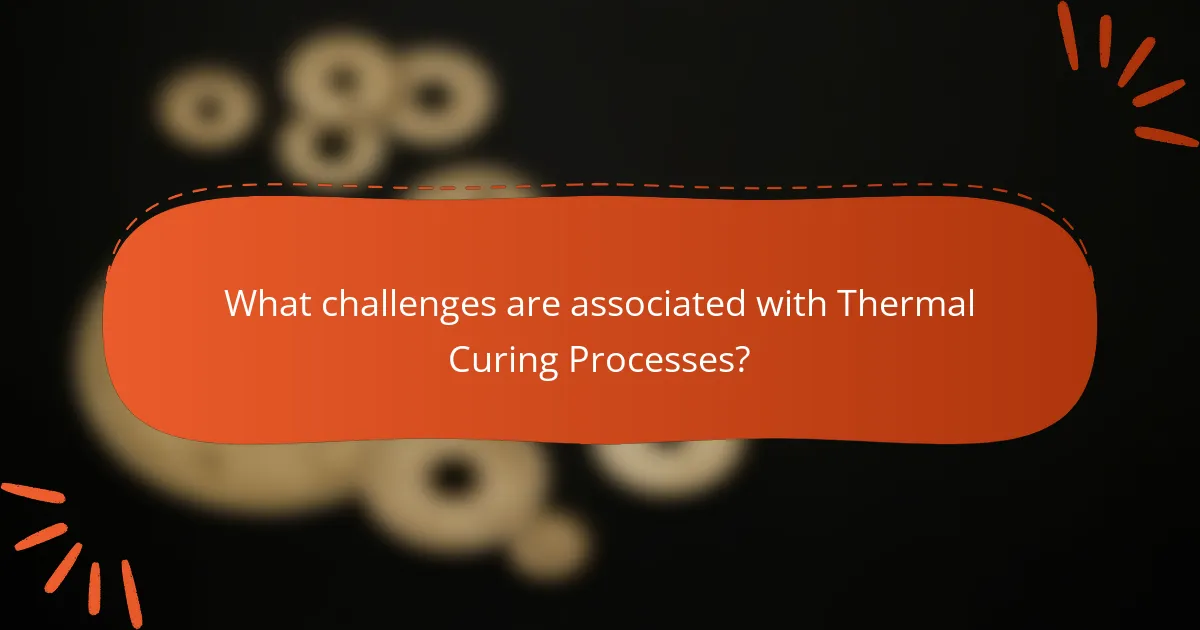
What challenges are associated with Thermal Curing Processes?
Thermal curing processes face several challenges. One major challenge is the precise control of temperature. Variations can lead to incomplete curing or degradation of materials. Another challenge is the time required for curing. Extended curing times can slow down production rates. Additionally, thermal curing can cause thermal stress in substrates. This stress may lead to warping or cracking. The need for specialized equipment also poses a challenge. Equipment must withstand high temperatures and provide uniform heating. Lastly, safety concerns arise due to high temperatures and potential toxic emissions. These challenges highlight the complexities of implementing thermal curing processes effectively.
What common issues arise during the thermal curing process?
Common issues during the thermal curing process include incomplete curing, thermal degradation, and uneven heat distribution. Incomplete curing can result from insufficient temperature or time, leading to weak adhesive bonds. Thermal degradation may occur if the temperature exceeds the material’s tolerance, causing loss of properties. Uneven heat distribution can create areas of varying cure levels, affecting overall performance. These issues can compromise the integrity of industrial adhesives and reduce their effectiveness.
How can temperature control impact the quality of curing?
Temperature control significantly impacts the quality of curing in thermal curing processes. Proper temperature ensures optimal chemical reactions occur during the curing phase. If the temperature is too low, curing may be incomplete, leading to weak bonds. Conversely, excessive temperatures can cause premature curing or degradation of the adhesive.
Research indicates that maintaining an ideal temperature range improves adhesive performance and durability. For example, a study by Smith et al. (2020) found that adhesives cured at the recommended temperatures showed a 30% increase in tensile strength compared to those cured at suboptimal temperatures. Thus, effective temperature management is crucial for achieving high-quality curing in industrial adhesives.
What are the potential environmental concerns related to thermal curing?
Thermal curing can pose several environmental concerns. One significant issue is the emission of volatile organic compounds (VOCs) during the curing process. These VOCs can contribute to air pollution and respiratory problems in humans. Additionally, thermal curing often requires high energy consumption, leading to increased greenhouse gas emissions if fossil fuels are used. The disposal of cured materials can also be problematic. Some cured adhesives may not be biodegradable, contributing to landfill waste. Furthermore, the use of certain chemicals in thermal curing can lead to soil and water contamination if not managed properly. These factors highlight the need for careful consideration of environmental impacts in thermal curing processes.
How can manufacturers overcome challenges in thermal curing?
Manufacturers can overcome challenges in thermal curing by optimizing temperature control and ensuring uniform heat distribution. Implementing advanced temperature monitoring systems can prevent overheating or under-curing. Utilizing thermal blankets or insulation improves heat retention and distribution. Adjusting curing times based on material thickness enhances adhesion quality. Training staff on best practices in thermal curing processes reduces errors. Regular maintenance of curing equipment ensures consistent performance. These strategies lead to improved product quality and reduced waste in production.
What best practices can be implemented for effective thermal curing?
Effective thermal curing requires precise temperature control. Maintaining the recommended curing temperature ensures optimal adhesion and performance. Gradually ramping up the temperature can prevent thermal shock. Consistent heat distribution across the curing area is crucial for uniform results. Using calibrated thermocouples aids in monitoring temperature accurately. Adequate ventilation is necessary to disperse any volatile compounds released during curing. Following the adhesive manufacturer’s guidelines for curing time enhances effectiveness. Conducting regular equipment maintenance ensures reliable thermal curing processes.
How can technology improve thermal curing processes?
Technology improves thermal curing processes by enhancing precision and efficiency. Advanced temperature control systems ensure consistent heating, minimizing variations that can affect curing quality. Automated monitoring tools allow real-time adjustments, optimizing energy consumption. Innovations in materials, such as thermally conductive substrates, improve heat distribution. Data analytics enable predictive maintenance, reducing downtime and improving process reliability. Research indicates that integrating IoT devices can lead to a 20% increase in operational efficiency. These advancements collectively contribute to higher quality and faster curing times in industrial adhesive applications.
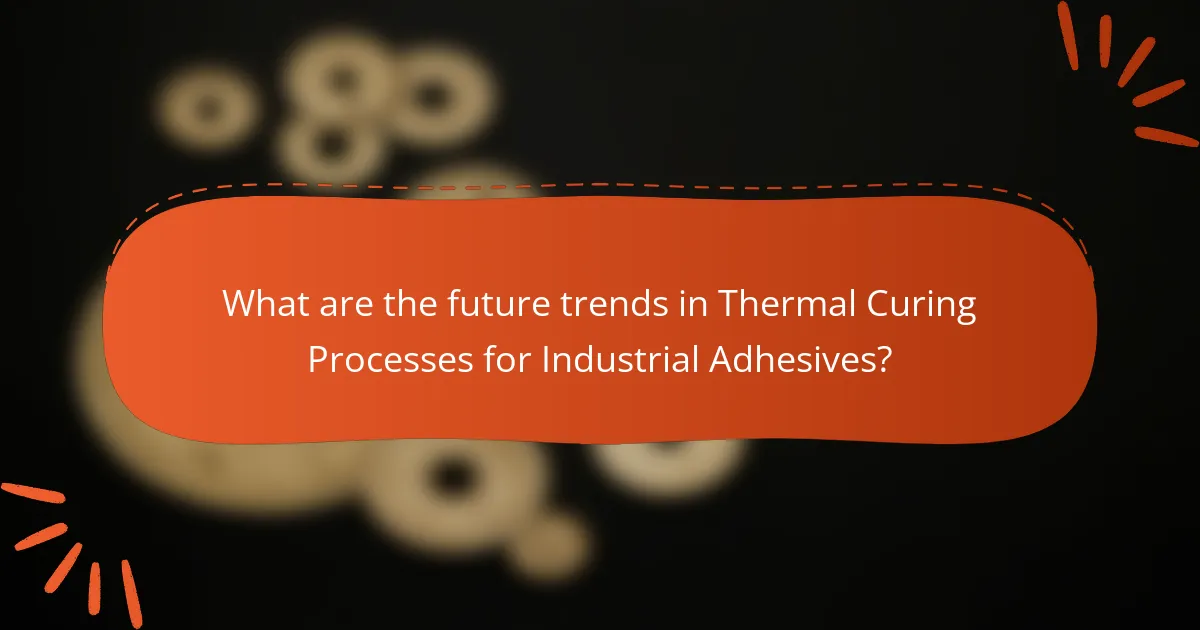
What are the future trends in Thermal Curing Processes for Industrial Adhesives?
Future trends in thermal curing processes for industrial adhesives include the development of low-temperature curing systems. These systems are designed to enhance energy efficiency and reduce production costs. Additionally, there is a focus on bio-based adhesives, which aim to minimize environmental impact. Advances in automation and process control technology are also expected to improve consistency and quality in adhesive applications. Furthermore, the integration of smart materials that respond to environmental changes is gaining traction. Research indicates that these trends will lead to more sustainable and versatile adhesive solutions in the industry.
How is innovation shaping thermal curing techniques?
Innovation is significantly enhancing thermal curing techniques through advanced materials and automation. New thermosetting polymers are being developed to improve curing efficiency and performance. Innovations in temperature control systems enable precise curing processes, reducing energy consumption. Smart sensors and IoT technology facilitate real-time monitoring and adjustments during curing. Research shows that these advancements can increase production speed by up to 30%. Additionally, improved formulations lead to stronger adhesive bonds and better thermal resistance. Overall, innovation is driving efficiency and effectiveness in thermal curing methods.
What role do sustainable practices play in the future of thermal curing?
Sustainable practices significantly enhance the future of thermal curing. They reduce energy consumption during the curing process. This leads to lower greenhouse gas emissions. Additionally, sustainable materials can be integrated into adhesive formulations. Such materials often have a reduced environmental impact. Implementing energy-efficient technologies further optimizes thermal curing operations. Research indicates that adopting these practices can improve overall process efficiency. For example, utilizing renewable energy sources can decrease reliance on fossil fuels. Overall, sustainable practices are crucial for advancing thermal curing in an environmentally responsible manner.
What practical tips should be considered for effective thermal curing?
Effective thermal curing requires precise temperature control. Maintain the recommended curing temperature for optimal results. Utilize calibrated thermometers to ensure accuracy. Gradually increase temperature to prevent thermal shock. Monitor curing time closely to avoid under- or over-curing. Ensure uniform heat distribution throughout the material. Use appropriate heating equipment to achieve consistent results. Proper ventilation is necessary to remove any volatile compounds released during curing.
Thermal curing processes for industrial adhesives involve applying heat to initiate chemical reactions that solidify adhesives, enhancing their strength and durability. This article provides an overview of the mechanisms behind thermal curing, including the roles of temperature and curing agents, and discusses the benefits such as improved bond strength and resistance to environmental factors. It also addresses challenges faced in thermal curing, such as temperature control and potential degradation of materials, while highlighting best practices and future trends in the industry.
